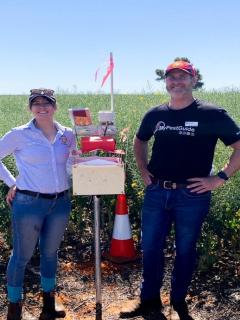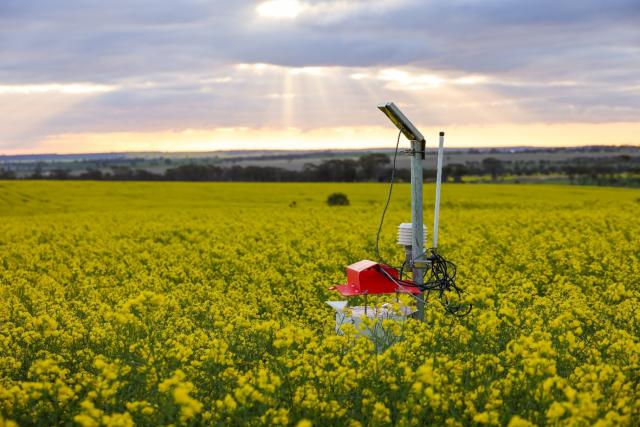Remote trapping of Diamondback moth

At a glance
- Diamondback moth (DBM) produce larvae which can cause yield losses in canola through feeding damage to leaves, stems, buds and flowers.
- DBM surveillance traps can give an early warning that DBM are present in the area.
- Automated traps are showing potential to replace traditional manual traps which are more time and labour consuming.
Diamondback moth (DBM) is a serious pest of canola crops as DBM caterpillars can cause up to 100% yield loss in the worst-case scenario. Traps are a valuable tool that indicate the presence of DBM moths in the landscape and they guide growers and consultants as to when they should start monitoring their canola crops for this pest.
There are two types of traps; manual and automated. Manual traps are labour intensive, as captured moth numbers need to be counted in-person and are less likely to be regularly checked by host growers. Both types of traps use pheromone lures that attract male DBM.
Automated traps automatically count moths and upload results daily using the 4G network. As part of a national iMapPESTS project, led by Hort Innovation, DPIRD entomologist Dr Dustin (Dusty) Severtson and research officer Christiaan Valentine have been investigating the viability of using automated pest traps to capture DBM. Trapview’s automated wing trap was trialled. With the current project coming to a close, GRDC investment is allowing for further testing and validation of Trapview’s wing trap.
Diamondback moth is a serious pest
DBM are difficult to control as they are prolific breeders, and under the right conditions, several generations can occur in one year. Insecticide can have limited effects, with resistance to most registered insecticides being a concern and multiple sprays required to achieve good control. DBM eggs are not affected by insecticides and so a second spray is often required to control new hatchings after the initial application.
Control of DBM caterpillars should be carefully considered and spraying decisions made based on threshold numbers.
Automated moth traps versus manual traps
Dusty and Christiaan trialled 17 automated Trapview wing traps across the grainbelt in 2021 and 2022, alongside manual Delta traps. Automated traps were paired with a manual trap and were placed 50 - 100m apart in paddocks. Manual traps were checked fortnightly; moth catches were automatically counted and uploaded daily via the 4G network for the automated traps. Automated traps were found to be as effective as manual traps in attracting male DBM (refer to Figure 1).

A DBM surveillance project funded by GRDC, with support from DPIRD’s Christiaan Valentine and Dusty Severtson and grower groups (Mingenew Irwin Group, West Midlands Group, Liebe Group and SEAR), monitored 51 focus canola crops across the grainbelt fortnightly for DBM. At each focus crop a manual trap was co-located. Traps captured adult DBM males from June until harvest. Surveillance found that catches of male DBM did not necessarily mean the adjacent crop had DBM caterpillars above threshold levels.
Threshold levels for control of DBM per 10 sweeps are:
- Pre-flowering - 30 or more grubs (stressed crops) or 50 or more grubs in crops with no stress
- Flowering canola - 50 or more caterpillars for early to mid-flowering canola or 100 or more in mid to late flowering crops.
When moths start being caught in traps, we can assume they are breeding and laying eggs in the crop. This gives growers a warning that DBM caterpillars will be damaging the crop approximately 4 weeks later. In 2021 and 2022 traps caught a moderate number of moths, though these numbers did not transition to above threshold caterpillar levels in most paddocks surveyed. In 2020 there was a high number of DBM moths caught in traps and this correlated with above threshold levels of DBM caterpillars in canola in some areas across the grainbelt.
This difference in trap catches and caterpillar numbers is likely to be a result of seasonal conditions. The 2021 and 2022 growing season was a decile 8-9 year, characterised by strong winds and heavy rainfall. These events may have contributed to lower caterpillar numbers. In contrast, during 2020 WA had a record warm winter with a decile of 2-3 for most of the grain growing areas, according to the Bureau of Meteorology.
For more information on DBM refer to DPIRD’s Diagnosing diamondback moth webpage or the 2022 PestFacts WA Issue 9 article Diamondback moth.

